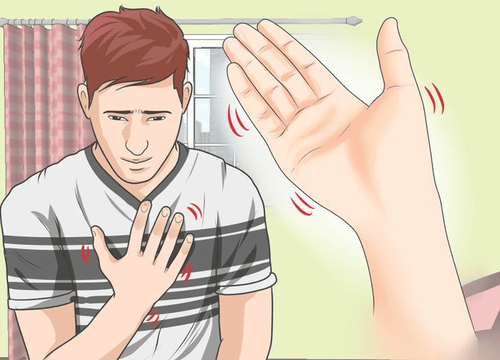This is an automatically translated article.
Bupropion is a reuptake inhibitor, causing the release of Dopamine and Norepinephrine. Bupropion inhibits dopamine reuptake 2 times stronger than norepinephrine reuptake inhibitor. This active ingredient is present in the drug Breakin. So what is Breakin?
1. What is Breakin?
What is Breakin drug? Breakin is a product of Dat Vi Phu Pharmaceutical Company Limited with the main ingredient being Bupropion, content 150mg. Breakin 150 is prepared in the form of film-coated tablets, packing box of 3 blisters, each blister of 10 tablets.
Bupropion is an antidepressant of the aminoketone group, the drug is not chemically related to 3 - 4 cyclic antidepressants. Bupropion inhibits the absorption of Serotonin, Norepinephrine and reuptake of Dopamine, thereby giving the ability to fight depression, helping patients avoid the shortfalls caused by lack of stimulants, lack of feeling of excitement like nicotine. In clinical practice, bupropion also supports nicotine withdrawal, after 12 months, the success rate is twice as high as that of smokers who do not use Bupropion.
2. Uses of the drug Breakin
Breakin 150 is indicated for use in the following cases:
Treatment of depressive disorders; Prevention of seasonal depressive episodes, which mainly occur in patients with seasonal affective disorder; Hyperactivity: When Breakin therapy is given to patients with attention deficit hyperactivity disorder, it usually begins with a CNS stimulant. In cases where the patient is unresponsive or intolerant, antidepressants may be used.
3. Dosage of Breakin
Breakin drug is used orally with the following dosage:
Treatment of depression: the starting dose of Breakin is 100mg/time - 2 times/day. Increase the dose of Breakin 100mg / time - 3 times / day after at least 3 days of using the drug (if necessary). In severe disease, if no improvement is seen after several weeks of treatment, the dose of Breakin can be increased to a maximum of 150mg/time - 3 times/day; Hepatic impairment: When treating depression, a reduction in the frequency and/or dose of Breakin should be considered in patients with mild to moderate hepatic impairment. In patients with severe cirrhosis, the maximum dose of Breakin is 75 mg/time - once/day; Renal Impairment: In the treatment of depression with Breakin, a reduction in the frequency and/or dose of Breakin should be considered. The recommended dose of Breakin in these patients is 150 mg once daily; Children: There have been no studies on the use of Breakin to treat depression in children, so Breakin should not be used in patients under 18 years of age.
4. What should I do if I overdose on Breakin?
Breakin overdose symptoms: Hallucinations, nausea, fast heart rate, loss of consciousness and possibly even death (large drug overdose). One-third of Bupropion overdoses have resulted in convulsions.
Management of Breakin Overdose: Consider using activated charcoal in adults taking more than 450 mg of Bupropion and do this for all children, if an emergency occurs within 1 hour of taking Bupropion. Gastric lavage may also be used to reduce the absorption of bupropion. Supportive treatment. Benzodiazepines can be used to treat seizures.
5. Side effects of the drug Breakin
When using Breakin, patients may experience undesirable effects:
Agitation, anxiety and insomnia often occur in the early stages of bupropion treatment. In addition, other common side effects of Breakin include: Fever, dry mouth, headache/migraine, dizziness, urinary frequency, vomiting and nausea, constipation, tremor, sweating odor and skin rash. Hypersensitivity reactions such as pruritus, urticaria, angioedema, dyspnea and anaphylactoid reactions have occurred; Rarely reported side effects of Breakin: Stevens-Johnson syndrome and erythema multiforme with tachycardia, chest pain, hypertension), vasodilation, orthostatic hypotension, palpitations chest, fainting, psychosis, confusion, nightmares, memory impairment, taste disturbances, anorexia, paresthesia, tinnitus, visual disturbances; Hyponatremia may occur when taking Breakin, due to inappropriate secretion of antidiuretic hormone when used with antidepressants, especially in the elderly; Breakin dose-dependent convulsions: may occur with bupropion, but special care should be taken in patients with anorexia nervosa, bulimia nervosa, patients with a history of seizure disorders or predisposing factors. other disease. The frequency of seizures in patients receiving the recommended dose of Breakin is approximately 0.1 to 0.4%. Other undesirable effects caused by Breakin:
Cardiovascular: Tachycardia, arrhythmia, myocardial infarction, chest pain, cardiac arrest; pain - tightness in the chest; Cerebral vascular system: Paresthesia, dizziness, tinnitus, confusion, gait disturbance after taking Breakin to quit smoking; Pancreas: Breakin can lead to pancreatitis and make pancreatic enzyme activity 3 times higher than normal; Side effects of the drug Breakin on the skin: Erythema multiforme, psoriasis, acute urticaria, flu-like symptoms; Extrapyramidal effects: Breakin causes dystonia of the head and neck muscles, affecting involuntary movements of the trunk, arms and legs; Hypersensitivity: Use of Breakin may cause eosinophilia, serum sickness, symptoms similar to serum sickness.
6. Contraindications to using Breakin
Before using Breakin, patients should carefully read the instructions for use. Accordingly, Breakin 150 is contraindicated for use in the following cases:
Seizure disorders; bulimia or anorexia nervosa; Patients receiving treatment or within 14 days of discontinuing MAOIs; Simultaneously treat Breakin with drugs containing Bupropion quite; Stopping alcohol or sedatives suddenly; History of hypersensitivity to Bupropion or any of the other ingredients of Breakin.
7. Be careful when using Breakin
Caution when using Breakin drug in the following cases:
Bupropion can cause convulsions, so Breakin is contraindicated in patients with epilepsy; Breakin is also contraindicated in patients with a history of anorexia nervosa or bulimia nervosa, in patients undergoing abrupt cessation of alcohol or benzodiazepines; Use Breakin with caution in patients with a history of seizure disorders while taking Breakin or with other risk factors such as severe cirrhosis, CNS tumours. Breakin should only be used in patients with other risk factors for seizures...; Use Breakin with caution in patients with bipolar disorder or psychosis; Use Breakin with caution in patients with a history of myocardial infarction, unstable heart disease and in patients with hepatic/renal impairment; When using Breakin for patients with depression, patients should be closely monitored from the beginning of treatment until there are significant improvements to prevent suicide risk; Keep Breakin out of reach of children; Similar to other drugs in the same class, Breakin has the potential to affect the central nervous system, affecting the ability to drive or use machines. Therefore, patients taking Breakin should not drive or operate machinery; The safety of Breakin for pregnant women has not been established. The risk to the fetus and the benefit to the mother should be carefully weighed when deciding to treat with Breakin; Breakin passes into breast milk, the effect of Bupropion on the nursing infant is unknown. However, caution should be exercised when using Breakin in lactating women.
8. Drug interactions of the drug Breakin
Drug interactions of Breakin drugs may occur during use as follows:
Combination of Breakin with Amantadine, Levodopa: increase unwanted reactions of Breakin drug; Carbamazepine, CYP2B6 inducers (efavirenz, phenobarbital, phenytoin, rifampicin) may decrease serum concentrations of Breakin; Cyclosporin concentrations may be reduced when combined with the drug Breakin ; The concentrations of drugs metabolised by CYP2D6 (desipramine, flecainide, haloperidol, iloperidone, imipramine, metoprolol, nortriptyline, propafenone, risperidone, tamoxifen, thioridazine) may be increased by Breakin; Drugs that lower the seizure threshold (antidepressants, antipsychotics, steroids, theophylline, tramadol) must be used with extreme caution in combination with Breakin; Guanfacine drug increases the risk of toxicity of Breakin, so the patient should be closely monitored during treatment; CYP2B6 inhibitors (cimetidine, clopidogrel, ticlopidine) may increase the plasma concentration of Breakin and increase the risk of adverse drug reactions; Patients using Nicotine as an alternative to therapy when taking Breakin together can cause an increase in blood pressure; Ritonavir may decrease the plasma concentration of Breakin leading to decreased efficacy; Breakin may inhibit the metabolism of some SSRIs, increasing their plasma concentrations; Tiagabine may increase the risk of seizures when taken with Breakin ; While taking Breakin, it is necessary to monitor the effect of anticoagulants and adjust the dose of warfarin as necessary. Breakin medicine has the main ingredient is Bupropion, 150mg content. This is an antidepressant of the aminoketone group, indicated for the treatment of neuropsychiatric diseases. To ensure effective use, users need to strictly follow the doctor's instructions, do not arbitrarily use to avoid serious health effects.
Follow Vinmec International General Hospital website to get more health, nutrition and beauty information to protect the health of yourself and your loved ones in your family.













